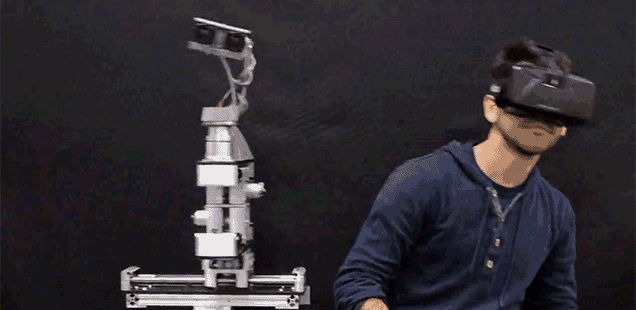Games and interactive movies are fun, but modern virtual reality systems like the Oculus Rift also have the ability to let people travel and experience the world without ever leaving their couch. And the DORA telepresence robot, which can perfectly match the movements of someone wearing a headset, will help make that VR experience even more immersive.
Instead of using a remote camera that captures a 360-degree view of everything going on around it so that an Oculus wearer can look around in all directions, robotics researchers at the University of Pennsylvania developed DORA — the Dexterous Observational Roving Automaton — with a pair of movement-matched cameras that serve as someone’s remote eyes.
Each of DORA’s cameras can stream live 976 x 582 video at 30 frames per second which is much less than what the latest version of Oculus Rift can display, but given the system is still in the research stages, there’s lots of room for improvement. A VR headset is already able to track the wearer’s movements and position, so that information is transmitted to DORA over a line-of-sight radio link allowing it to perfectly mimic every turn, move, and subtle shift. And since it’s mounted on a mobile robotics platform, it can let someone wearing a VR headset explore wherever they wanted.

The biggest hurdle for DORA’s researchers to overcome right now is the lag between the VR headset’s movements and the robot’s cameras. When latency is below 20 milliseconds, it’s no longer perceptible to someone wearing a VR headset. And Oculus has suggested that a latency of 60 milliseconds is the upper limit to making the VR experience believable. But DORA’s latency currently sits at around 70 milliseconds — partly due to the speed of its mechanical components — and that could be even longer if the system were dependent on a wireless internet connection instead of radio like it’s currently using.
But the potential for such a robot is staggering. It could give those living with disabilities a new sense of freedom and movement. Emergency responders would be able to safely explore an area too dangerous for humans to enter without the restrictions of a static camera mounted to a more traditional robot. And museums or art galleries could even rent out a DORA-like robot to allow visitors from around the world peruse their collections without having to spend a dime on airfare. Although humanity’s future as predicted in Pixar’s WALL•E edges unsettling closer.
[DORA via IEEE Spectrum]
